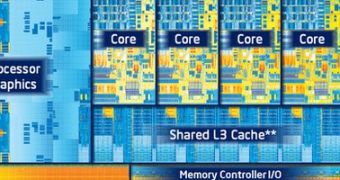Even though sales aren't going to begin until April 29, Intel has officially spoken of its first central processing units based on the 22nm manufacturing process.
Thirteen third-generation chips have been revealed, most of which are aimed at desktops, although the high-end laptop parts are there as well.
Regardless, all are quad-core models with higher performance and energy efficiency than the previous-generation Core series.
The Core i7-3770 is the strongest of the lot, having been pushed to 6.74 GHz on the Maximus V GENE motherboard not long ago.
Meanwhile, the Core i7-3612QM is the star of the laptop collection.
In fact, this particular quad-core chip has already become part of the HP dm4-3110tx Beats Edition mobile workstation. And yes, this laptop is somehow already selling (in China anyway).
We'll talk more about the processors themselves whenever Intel finally decides to open the floodgates on the CPU series. In the meantime, we'll check out the general assets that the BBC got Intel's first statements on.
On average, the Ivy Bridge collection of CPUs is said to provide a 20% increase in processor performance while consuming 20% less electricity.
What stands out at least as much is the implementation of 3D Tri-Gate transistors, which employ super-thin fins that rise up from the silicon base instead of the normal, 2D gates.
Regular, planar gates switch on and off as quickly as possible, allowing the maximum and minimum amount of current to pass in each respective state.
With 3D transistors, the gates are wrapped around each fin, two on each side and a third at the top.
In addition to increasing the number of transistors that can be packed in the same die space, this approach reduces the power needed to carry out an action, reduces leakage to almost zero and still allows gates to switch over 100 billion times per second. All this for just 2-3% extra chip cost.
A final asset is, of course, the GMA HD 4000 integrated graphics unit, which was shown to be quite the upgrade over HD 3000.

 14 DAY TRIAL //
14 DAY TRIAL //